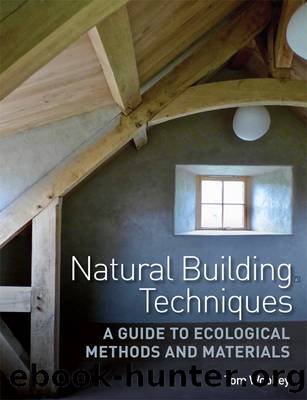Natural Building Techniques by Woolley Tom;

Author:Woolley, Tom;
Language: eng
Format: epub
Publisher: The Crowood Press
Insulation Properties of Hempcrete
As pressure increases to ensure that buildings meet with zero or net carbon standards, officialdom and the industry are moving towards so-called super-insulating materials to provide excellent thermal resistance. Claims about super-insulation are greatly exaggerated and research has revealed a massive performance gap (15) where buildings using conventional construction methods and synthetic insulations can perform up to 70 per cent worse than predicted. Hempcrete, which provides a modest U value of 0.2, is rejected by many as not providing sufficient insulation, but this is because current methods of calculating thermal performance have been designed to favour lightweight synthetic materials while ignoring thermal mass. An explanation about thermal insulation in more detail can be found in the book by Latif et al. (2019). (16)
There a number of reasons for the good thermal performance of hempcrete:
1.Thermal comfort: due to the ability of hempcrete to regulate humidity the occupants will feel more comfortable and not tempted to turn up the heat to mitigate the effects of cold walls.
2.Hempcrete maintains steady internal temperatures whatever is happening outside, which means that any additional heating is minimized to raise the temperature to an acceptable level. Cooling should not be required in hot weather.
3.Hempcrete has the enormous benefit of thermal mass while also providing a good level of insulation. Thermal mass is found in earth, concrete and masonry buildings, but without the same level of insulation.
4.To understand this means understanding the âdecrement factorâ: that is, the process by which certain materials are quicker or slower to heat up or cool down. The time lag with lightweight insulated buildings is quite short and even with super-insulated materials, heat is lost through the fabric surprisingly quickly. With hempcrete the heat loss is so slow that the building retains warmth. Research has shown that in a conventional synthetic-insulated building, internal temperatures mirror the external conditions, whereas in a hempcrete building the temperature stays almost constant. This can also be achieved in straw and earth buildings.
5.When thermal performance is calculated for building regulations using the Standard Assessment Procedure (SAP), thermal mass is barely considered, to the disadvantage of hempcrete.
Download
This site does not store any files on its server. We only index and link to content provided by other sites. Please contact the content providers to delete copyright contents if any and email us, we'll remove relevant links or contents immediately.
Whiskies Galore by Ian Buxton(41544)
Introduction to Aircraft Design (Cambridge Aerospace Series) by John P. Fielding(32897)
Small Unmanned Fixed-wing Aircraft Design by Andrew J. Keane Andras Sobester James P. Scanlan & András Sóbester & James P. Scanlan(32583)
Craft Beer for the Homebrewer by Michael Agnew(17940)
Turbulence by E. J. Noyes(7720)
The Complete Stick Figure Physics Tutorials by Allen Sarah(7154)
Kaplan MCAT General Chemistry Review by Kaplan(6606)
The Thirst by Nesbo Jo(6458)
Bad Blood by John Carreyrou(6286)
Modelling of Convective Heat and Mass Transfer in Rotating Flows by Igor V. Shevchuk(6232)
Learning SQL by Alan Beaulieu(6048)
Weapons of Math Destruction by Cathy O'Neil(5855)
Man-made Catastrophes and Risk Information Concealment by Dmitry Chernov & Didier Sornette(5676)
Digital Minimalism by Cal Newport;(5404)
Life 3.0: Being Human in the Age of Artificial Intelligence by Tegmark Max(5201)
iGen by Jean M. Twenge(5175)
Secrets of Antigravity Propulsion: Tesla, UFOs, and Classified Aerospace Technology by Ph.D. Paul A. Laviolette(5024)
Design of Trajectory Optimization Approach for Space Maneuver Vehicle Skip Entry Problems by Runqi Chai & Al Savvaris & Antonios Tsourdos & Senchun Chai(4851)
Electronic Devices & Circuits by Jacob Millman & Christos C. Halkias(4760)
